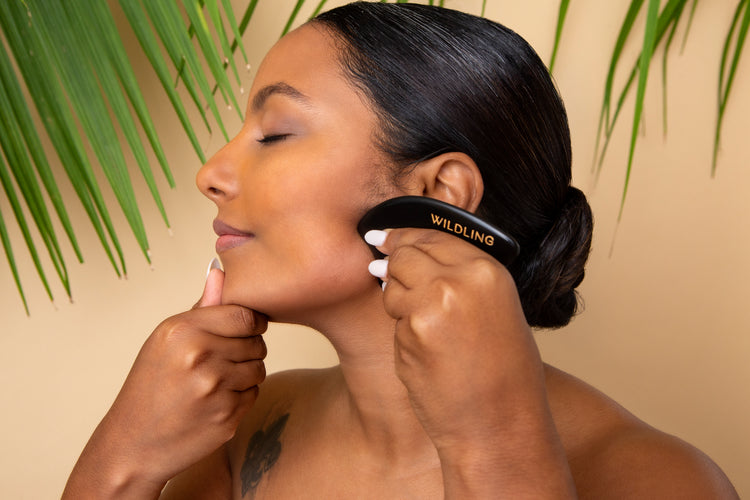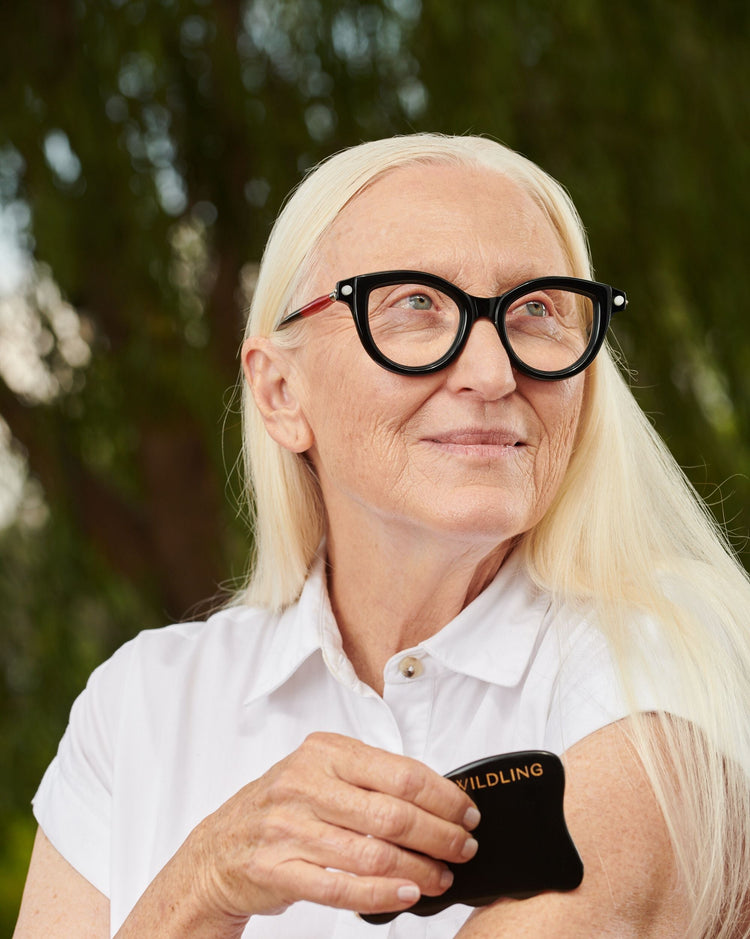Reviewed by: Britta Plug
If you type “gua sha” or “facial gua sha” into the Google, it will return a mix of shopping results for facial gua sha tools, gua sha video tutorials, articles about the ancient traditional Chinese medicinal practice, and images of reddened skin, broken capillaries, and bruising on the body. Don’t let these images intimidate you! Modern facial gua sha is quite different from the body-scraping practices you might see online. Our facial gua sha method won’t give you bruises, it'll help give you a glorious glow and release long-held facial tension, while addressing aging concerns and breakouts along the way. If you want to learn more about facial gua sha, you’ve come to the right place.
What is facial gua sha?
Facial gua sha is a form of gentle self-massage adapted from the traditional Chinese medicine technique that entails using a flat stone with specific strokes to help the skin with its natural healing processes. Ideally, the gua sha tool is a stone that's been designed to suit the contours of the face, like our Empress Stone.
The foundational practice of gua sha involves slow, steady strokes that can create the appearance of lift, tone, clarity, and brightness in the face both immediately, and with enhanced results over time.
Can you do facial gua sha with Botox?
The answer is a little nuanced, so hear us out! Some experts have dubbed facial gua sha a natural alternative to injectables like Botox, and we couldn't agree more! Interestingly, though, it works in the opposite way. Botox freezes the face and the muscles around it, while gua sha infuses the tissues with blood and chi (or “qi”), the traditional Chinese medicine word for energy, or “life force.” In this way, it's best to avoid areas of the face that contain injectables when doing your gua sha ritual. Instead, do parts ofyour face that don't have injectables, do gua sha between appointments, or if you're ready, use gua sha to transition off of them all together. One of the reasons we created Wildling was to give people more anti-aging (not our favorite word, by the way, we adore an older, wiser look) options that can approximate the efficacy of more extreme and invasive treatments.
We recommend using a toner and an oil for any gua sha practice, but particularly for the face. The oil provides "slip" for the stone and will help in avoiding any markings or bruising. Our Empress Oil was specifically formulated with live botanicals and actives to help boost circulation and complement your daily gua sha practice.
How is facial gua sha different from body gua sha?
Instead of using lots of pressure and quick scraping motions from traditional bodywork methods, facial gua sha is a gentle but firm, slow pull that manipulates the skin as well as the layers underneath. The intent is often the same — all gua sha aims to help to move blood, lymph, and manipulate sub-dermal fascia in an area that's stagnant.
Today, like thousands of years ago, traditional gua sha is practiced on the body by acupuncturists and traditional Chinese medicine practitioners. It involves vigorous, sometimes painful, scraping that’s meant to increase blood flow and chi, or qi (our bodies’ life force) in an area of the body that needs healing. Practitioners work with the meridians of the body as well as locally to generate a minor “wound” that the body responds to with its natural healing processes.
Read more: The differences between facial gua sha and body gua sha, explained.
More recently, facial gua sha has become a treatment all its own. One of the main and immediate benefits of gua sha is lymphatic movement and drainage. Lymph, the colorless liquid in our bodies that stores white blood cells and hydrates our tissues, moves through the lymph nodes and lymphatic system, and eventually makes it way into the bloodstream. The major drainage spot for lymph is at the base of the neck, which is one of the reasons it’s so important to start and finish with the neck in your facial gua sha practice.
What are the benefits of facial gua sha?
You can expect a decrease in face puffiness and an overall youthful glow after doing just one gua sha routine — and over time, deeper wrinkles and tension in the face begin to release. While gua sha for the face is different from a gua sha body treatment, most of the research and studies on gua sha have been done on the bodywork. It’s worth taking a look at how this ancient modality can shift pain levels and stimulate healing because it’s essentially doing the same thing for the face, just at a more gentle, subtle scale and rate.
Gua sha on the body has been associated with short-term benefits for people with chronic neck pain, chronic low back pain, and has been shown in two small-scale studies to increase blood circulation, increase blood volume, and decrease pain levels.
Both studies measured arbitrary perfusion units, which is a fancy way of saying blood flow, using Laser Doppler Imaging at the surface of the skin before and after gua sha treatment. One study found that circulation increased 400 percent on areas treated with gua sha scraping, and the increase in circulation continued for more than 25 minutes after treatment. In between visits, patients reported that pain relief was sustained to some degree. In another study that used Laser Doppler Imaging to measure blood flow to the treated area at different intervals, 0, 15, 30, 60, and 90 minutes after treatment, and found that the surface temperature and blood volume was significantly increased even after 90 minutes post-scraping when compared to a baseline of no scraping, which helps to improve circulation and energy metabolism.
Read more: 5 common gua sha mistakes, and exactly how to fix them.
This is all to say that gua sha treatments can indeed effect measurable change by increasing circulation, blood flow, and blood volume. In the face, a regular gua sha practice activates the tissues, the lymph, and lifts the contours of the face with the same mechanisms, just at a gentler pace and scale. Below we discuss some of the benefits of a regular facial gua sha practice — while some are immediate, others come with time, patience, and care.
Is gua sha good for wrinkles?
In short, yes! By stimulating blood flow, draining lymphatic fluids, and helping to comb out long-held patterns of facial tension, gua sha facials can absolutely help to soften wrinkles. Here's how it works: Stimulating blood flow has a lot of benefits particularly for the skin. One happy side effect of facial gua sha is that it can increase collagen production by way of, you guessed it, stimulating blood circulation. Collagen is a protein that our skin naturally makes — it’s the most abundant protein in the body — but production decreases as we get older, which contributes to the look of aged skin. Increasing collagen production has been associated with more plumpness and less gravity-induced sag. Gua sha therapy also manipulates the fascia, muscles, and layers underneath the dermis, which contributes to a sculpted look over time.
Can gua sha get rid of fine lines?
It sure can — a regular gua sha practice is constantly renewing and rejuvenating the fluids in the face. Using the basic strokes (tutorials are featured on our Instagram highlights) with consistency, you’ll be helping blood, lymph, and fluids move, undoing stagnation and resulting in a face with improved circulation. Special techniques with the gua sha stone (we’ll share them in a future article!) can help target wrinkles specifically and locally, further releasing the deep fascial creases beneath the surface of the skin and allowing chi to flow there, plumping up fine lines and wrinkles.
Does gua sha help with puffiness?
Yes, even just a single one-minute session of gua sha can help puffiness from the face drain. In addition to increasing blood flow, lymph drainage is a key benefit of facial gua sha. When we’re puffy, the face is typically holding onto excess fluid whether it’s from eating a salty meal the night before, allergies, or — let’s be honest — a good cry. Holistic esthetician and gua sha expert Britta Plug often says that the neck is the lymphatic “highway” to the face. By treating the neck, lymph and excess fluids from the face are given a helping hand and a place to go — down and out! You never want to skip the neck.
Read more: How gua sha's lymphatic drainage delivers immediate results.
Many gua sha practitioners report that they look more awake when they’re committing to a daily practice, even if the practice is just a couple of minutes. Gua sha works some kind of magic around the eye area. It helps to depuff the sensitive skin under the eyelid, can help to drain a droopy or hooded eyelid, and also helps release tension between the brows, creating a “lifted” and more awake look. Here's one of our favorite gua sha rituals for the eyes.
Can gua sha help with breakouts?
Because gua sha works with the epidermis and dermal layers underneath, it has the potential to help clear chronic blackheads, whiteheads, and prevent hormonal breakouts. Sometimes starting a gua sha practice can aggravate the skin and cause a breakout — this happens and you should know it's a totally normal, common response. It’s like you’re stirring up debris that’s settled at the bottom of a lake, the debris needs somewhere to go. Up and out! This is part of the detoxification process that can get a little worse before it gets better. That being said, we don't recommend gua sha on skin that’s experiencing an active breakout or is otherwise inflamed. Doing so could agitate it further.
Read more: Everything you need to know about doing gua sha on breakout prone skin.
Can gua sha really brighten the skin?
It's definitely possible. Another positive effect of increasing blood and lymph circulation? Addressing hyperpigmentation. Stimulating blood flow can help to repair microwounds, scarring, and hyperpigmentation in the skin, as facial gua sha brings blood to these areas and can help the healing process along.
Does gua sha help with stress?
We tend to think so — any act of self-care, gua sha included, can help alleviate feelings of stress. Whether you’re getting a gua sha facial (lucky you) or you’re doing the practice yourself (good on you), facial gua sha can help put the mind and body at ease. Nonsexual physical touch, whether it is self touch or from another, has been shown to be enormously beneficial for the human body. Touch can boost feelings of physical and emotional well-being, it can chemically stimulate feel-good hormones while lowering blood pressure, and, last but not least, it has the superpower of abating intense feelings of stress as they are happening. Receiving facial gua sha from yourself or from another is a form of self-love and in our touch-deprived way of living and being, is an important part of caring for yourself.
If you're interested in giving gua sha a try, we recommend the Empress Collection and joining our 21-day challenge. They say it takes 21 days to form a new habit — so we put together a program where everything is laid out for you! You'll get a daily email with fun facts, inspiration, and a new ritual to try with your stone and products for 21 days. If you have the stone and want to try our Empress Ritual, we've embedded the video here! It's a perfect place to begin.













